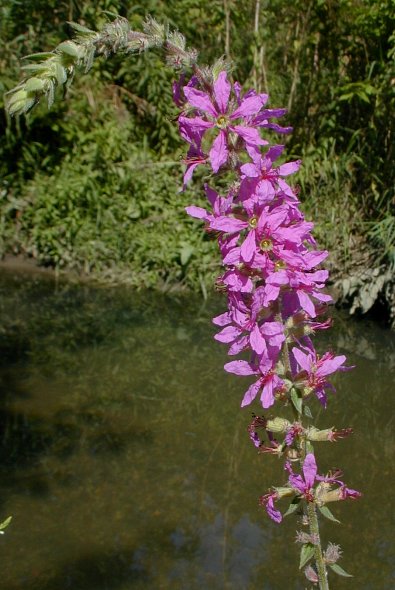Description: This perennial plant is 2-5' tall, branching frequently below the inflorescence. The stems are variably hairy, becoming woody and glabrous below. The leaves are usually opposite, less often whorled in 3's; some of the upper leaves in the inflorescence may be alternate. These leaves are up to 4" long and ¾" across, becoming smaller as they ascend the stems. They are lanceolate, smooth along the margins, slightly hairy (especially the upper leaves), and clasp the stems. The upper stems terminate in long spikes of flowers about ½–2' long.

Each flower is
about ½–1" across, consisting of 6 purple petals, a green tubular
calyx, 6 or more stamens, and a pistil with a stigma that is green and
knobby. Each wrinkly petal has a dark purple line toward its base. The
hairy calyx has 5 teeth at its apex and several veins along its length.
Sometimes the flowers have fewer than 6 petals, and the relative length
of their pistils and stamens is variable (in this regard, there are 3
different forms of flowers). The flowers are sessile against the
flowering stalks, or they have very short pedicels. The blooming period
occurs from mid-summer to early fall, and lasts about 2 months. Each
flower is replaced by a small seed capsule that is surrounded by the
tubular calyx. This capsule contains many tiny seeds that can float on
water or be blown about by the wind. The root system is shallow and
fibrous, frequently forming offsets by rhizomes. This plant often forms
colonies, and can spread by its seeds, rhizomes, or segments of the
roots and stems.
Cultivation:
The preference is full or partial sun, wet to moist conditions, and a
mucky soil containing organic matter. Ordinary garden soil containing
loam is satisfactory as long as there is adequate moisture. This plant
can spread aggressively in some situations and can be difficult to
destroy.

Range &
Habitat:
Purple Loosestrife occurs occasionally in NE Illinois and scattered
counties elsewhere (see Distribution
Map). It was introduced into the United States from Europe as
a horticultural plant because of the showy flowers. Habitats include
fens, marshes, borders of ponds and rivers, and ditches. This is
species is still grown in flower gardens, using hybrids that are
supposedly sterile. However, research has revealed that many of these
hybrids can form viable seeds when wild forms of Purple Loosestrife are
present in a given locality as a result of cross-pollination between
these two groups of plants. Purple Loosestrife often escapes from
cultivation and invades wetlands, sometimes forming dense stands that
exclude other plants. This plant has become a major problem in
Wisconsin and some of the northeastern states.
Faunal Associations:
The flowers attract long-tongued bees and butterflies, including Bombus
spp. (Bumblebees) and the butterfly Pieris rapae
(Cabbage White). The seeds are too small to be of any interest to
birds, and it is unclear to what extent mammalian herbivores feed on
the foliage. There have been attempts recently to release leaf beetles
from Europe as a biocontrol measure. This species probably provides
cover to some wetland species of birds because of its tall dense
vegetation.

Photographic
Location:
Along a large drainage ditch near Kaufman Lake Park in Champaign,
Illinois. This colony of plants has been destroyed.
Comments:
The only other species that is similar to Purple Loosestrife is the
native Lythrum alatum (Winged Loosestrife), which
also occurs in wetlands. This latter species is a smaller and less
aggressive plant with winged stems, while the stems of Purple
Loosestrife are usually round (sometimes 4-angled). Their flowers are
similar in appearance, although Winged Loosestrife has smaller flowers
(½" across or less).